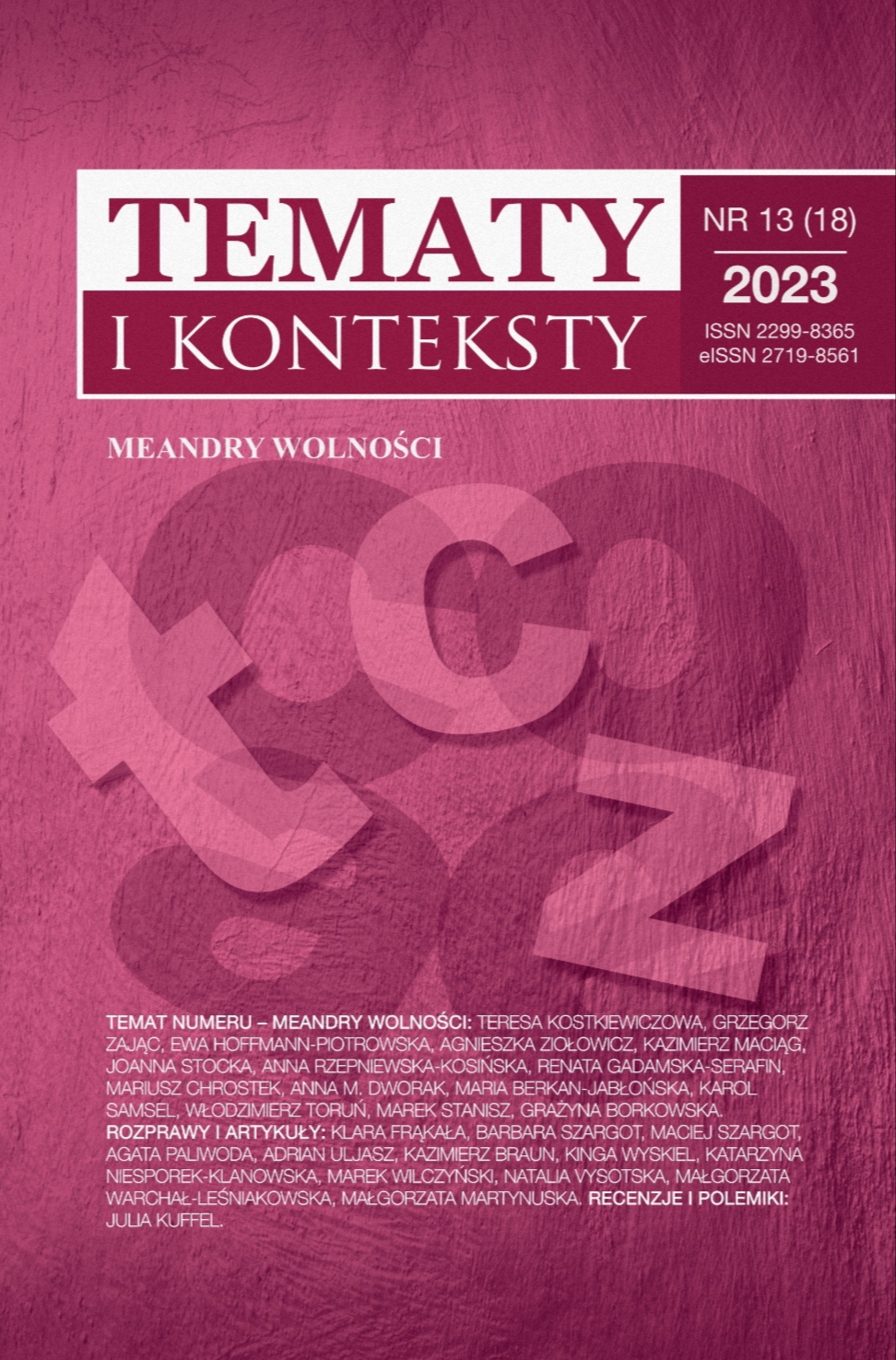Powieść kryminalna Karin Slaughter "Zaślepienie" jako thriller medyczny z amerykańskiego Południa
DOI:
https://doi.org/10.15584/tik.2023.26Słowa kluczowe:
kryminał, thriller medyczny, dowód naukowy, amerykańskie PołudnieAbstrakt
Thriller medyczny stanowi podgatunek kryminału przedstawiający pracę lekarzy sądowych, koronerów, patologów i antropologów, analizujących dowody naukowe. Śledczy sądowi nie włączają się bezpośrednio w ściganie przestępców, a jedynie badają dowody zebrane z ciał ofiar i miejsc zbrodni. Popularność powieści, filmów i seriali z gatunku thrillera medycznego wpłynęła na przekonanie o stosowaniu kryminalistyki w rutynowych procedurach policyjnych. Niniejszy artykuł analizuje powieść Zaślepienie (2002), autorstwa Karin Slaughter, jako przykład regionalnego thrillera medycznego. Pisarka amerykańska Karin Slaughter jest autorką kryminałów i thrillerów, których miejscem akcji jest amerykańskie Południe. Seria Hrabstwo Grant składa się z sześciu powieści: Zaślepienie, Płytkie nacięcie, Zimny strach, Fatum, Niewierny, Przywilej skóry. Artykuł przedstawia charakterystykę thrillera medycznego i podkreśla przynależność gatunkową powieści Zaślepienie. Następnie analizuje powieść w kontekście specyfiki literatury regionalnej amerykańskiego Południa.
Downloads
Bibliografia
Anušauskaite, Migle, The Role of the Body in Forensic Crime Fiction, “Acta Academiae Vilnensis”, Vol. 80-81, 2016, 135-144.
Arntfield, Michael, Gothic Forensics: Criminal Investigative Procedure in Victorian Horror and Mystery, Palgrave Macmillan, 2016.
Ascari, Maurizio, A Counter – History of Crime Fiction: Supernatural, Gothic, Sensational, New York: Palgrave Macmillan, 2007.
Avanzas Álvarez, Elena, Forensic Science and Forensic Thrillers: A Feminist Perspective on the Re/Presentation of the Female Corpse, “HARTS & Minds: The Journal of Humanities and Arts”, Vol. 3, No.1, (Issue 8), 2016, 2-13.
Baskin, Deborah R. and Ira B. Sommers, Crime-Show-Viewing Habits and Public Attitudes Toward Forensic Evidence: The “CSI Effect” Revisited, “The Justice System Journal”, Vol. 31, No. 1, 2010, 97-113.
Bell, David, Anti-Idyll: Rural Horror [in:] Contested Countryside Cultures: Otherness, Marginalization and Rurality, ed. Paul Cloke and Jo Little, London and New York: Routledge, 1997, 91-104.
Bertens, Hans and Theo D’haen, Contemporary American Crime Fiction, New York: Palgrave Macmillan, 2001.
Botting, Fred, Gothic, London and New York: Routledge, 1999.
Cavallaro, Dani, Gothic Vision: Three Centuries of Horror, Terror and Fear, London and New York: Continuum, 2002.
Chou, Jun-nan, Seeing Bones Speaking: The Female Gaze and the Posthuman embodiment in Reichs’s Forensic Crime Fiction, “Concentric: Literary and Cultural Studies”, Vol. 38, No. 1, 2012, 145-169.
Close, Glen, S., Female Corpses in Crime Fiction: A Transatlantic Perspective, London, UK: Palgrave Macmillan, 2018.
Cole, Simon A. and Glenn Porter, The CSI effect, [in:] The Routledge International Handbook of Forensic Intelligence and Criminology, ed. Quentin Rossy, David Décary-Hétu, Oliver Delémont, and Massimiliano Mulone, Routledge, 2017, 112-124.
Czubaj, Mariusz, Etnolog w Mieście Grzechu: Powieść kryminalna jako świadectwo antropologiczne, Gdańsk: Oficynka, 2010.
Dauncey, Sarah, Crime, Forensics, and Modern Science, [in:] A Companion to Crime Fiction, ed. Charles J. Rzepka and Lee Horsley, Malden, MA: Wiley-Blackwell, 2010, 164-174.
Doane, Ashley. (“Woody”), Beyond Color-blindness: (Re)Theorizing Racial Ideology, “Sociological Perspectives”, Vol. 60, No. 5, 2017, 975-991.
Dunant, Sarah, Body Language: A Study of Death and Gender in Crime Fiction, [in:] The Art of Detective Fiction, ed. Warren Chernaik, Martin Swales and Robert Vilain, New York: Palgrave Macmillan, 2000, 10-20.
Evans, Mary, The Imagination of Evil: Detective Fiction and the Modern World, London and New York: Continuum, 2009.
Goddu, Teresa, Gothic America: Narrative, History, and Nation, New York: Columbia University Press., 1997.
Head, Beth, A Normal Pathology? Patricia Cornwell’s Third-Person Novels, [in:] The Millennial Detective: Essays on Trends in Crime Fiction, Film and Television, 1990-2010,
ed. Malcah Effron, Jefferson, North Carolina and London: McFarland & Company, 2011, 36-49.
Page, Graeme, Sharp Objects as Southern Gothic for the Twenty-First Century: A Novel Analysis, “Medium”, 22 January, 2023. Accessed 24 November, 2023. Available on https://medium.com/@graeme-page/sharp-objects-as-southern-gothic-for-the-twenty-first-century-an-analysis-3a189b847dbb.
Palmer, Joy, Tracing Bodies: Gender, Genre, and Forensic Detective Fiction, “South Central Review”, Vol. 18, No. 3/4, 2001, 54-71.
Peach, Linden, Masquerade, Crime and Fiction: Criminal Deceptions, New York: Palgrave Macmillan, 2006.
Penfold-Mounce, Ruth, Corpses, Popular Culture and Forensic Science: Public Obsession with Death, “Mortality”, Vol. 21, No. 1, 2016, 19-35. Available on White Rose Research Online, pp. 1-26. Accessed 2 November, 2021. https://eprints.whiterose.ac.uk/95708/
Schatz, Thomas, Hollywood Genres: Formulas, Filmmaking, and the Studio System. New York: Random House, 1981.
Schmid, David, The Locus of Disruption: Serial Murder and Generic Conventions in Detective Fiction, [in:] The Art of Detective Fiction, ed. Warren Chernaik, Martin Swales and Robert Vilain, New York: Palgrave Macmillan, 2000, 75-89.
Slaughter, Karin, Blindsighted, London: Arrow Books, 2002.
Slaughter, Karin, website. Accessed 13 October, 2021. https://www.karinslaughter.com/bio-1
Smith, Andrew, Gothic Literature, Edinburgh: Edinburgh University Press, 2007.
Steenberg, Lindsay, “A Natural Instinct for Forensics”: Trace Evidence and Embodied Gazes in The Bone Collector, [in:] The Millennial Detective: Essays on Trends in Crime Fiction, Film and Television, 1990-2010, ed. Malcah Effron. Jefferson, North Carolina and London: McFarland & Company, 2011, 112-127.
Wenner Moyer, Melinda, Do Money, Social Status Woes Fuel the U.S. Gun Culture, “Scientific American”, 13 December, 2017. Accessed 24 November, 2023. Available on https://www.scientificamerican.com/article/do-money-social-status-woes-fuel-the-u-s-gun-culture/
Yamane, David, The Sociology of U.S. gun culture, “Sociology Compass”, No 11, 2017, 1-10.
Pobrania
Opublikowane
Jak cytować
Numer
Dział
Kategorie
Licencja
Prawa autorskie (c) 2023 Tematy i Konteksty

Utwór dostępny jest na licencji Creative Commons Uznanie autorstwa – Użycie niekomercyjne – Bez utworów zależnych 4.0 Międzynarodowe.




